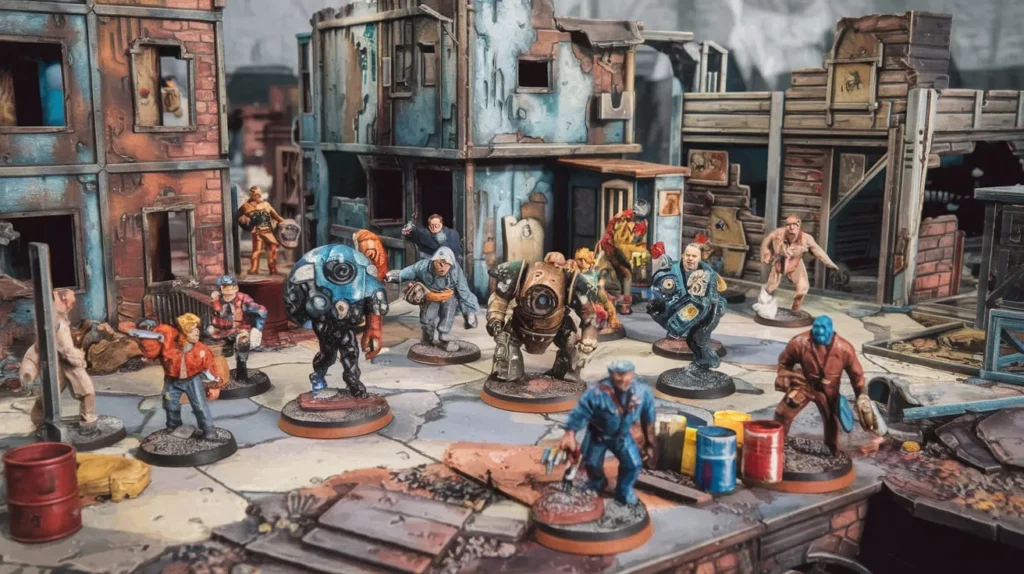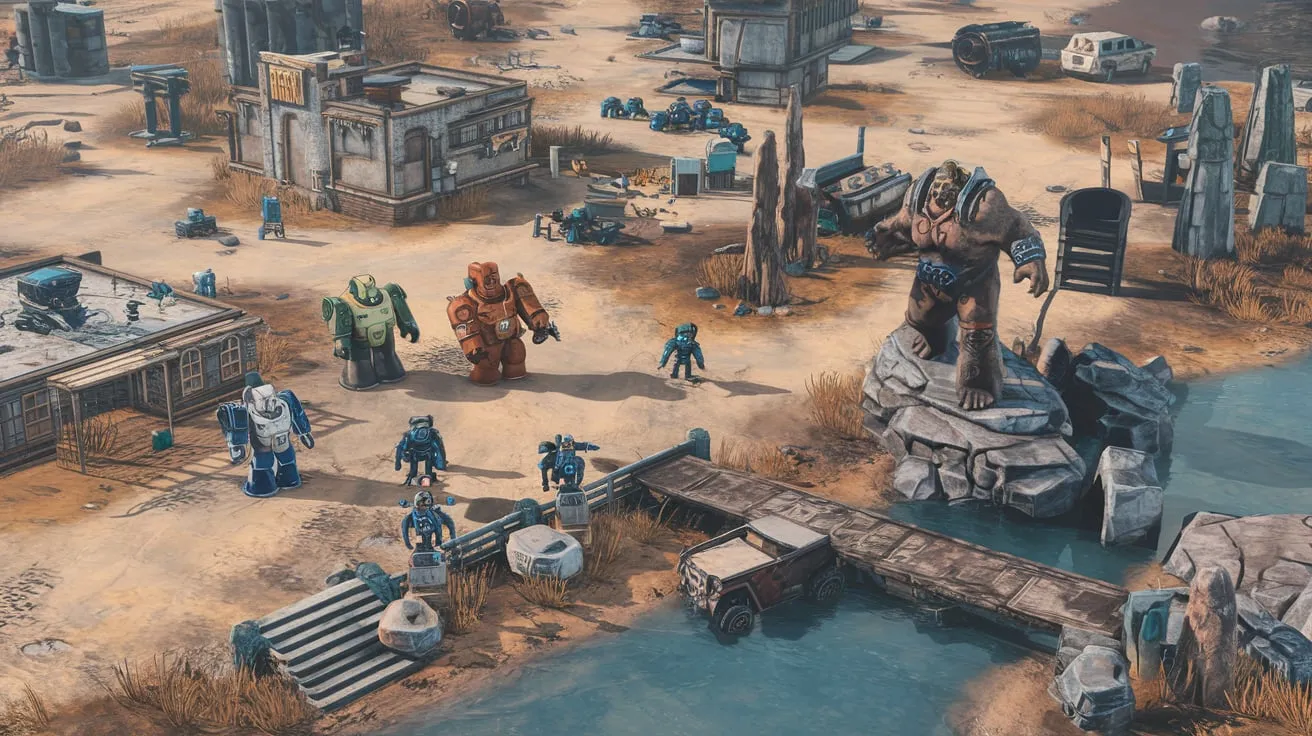Introduction
The Fallout tabletop wargame brings one of the most beloved video game franchises into the realm of tabletop gaming. Combining strategic gameplay with rich lore, it offers players a chance to explore the post-apocalyptic wasteland in an interactive and engaging format. This comprehensive guide will delve into various aspects of the game, providing valuable insights for both newcomers and experienced players.
Understanding the Basics of Fallout Tabletop Wargame
At its core, the Fallout tabletop wargame is a tactical skirmish game where players take on the roles of characters navigating through a nuclear dystopia. Players build their teams, engage in combat, and complete missions that reflect the rich narrative of the Fallout universe. Familiarity with the game’s mechanics is crucial for creating a fun and strategic playing experience.
The History and Evolution of the Game
Originating from the massively popular Fallout video game series, the tabletop version was conceived to provide fans with a new way to engage with the lore and characters. The first edition was released following the success of earlier titles, and since then, it has evolved through various expansions that introduce new factions, characters, and gameplay mechanics. The growth of the game reflects its loyal community and the ongoing interest in the Fallout world. Over the years, the game has also incorporated feedback from its players, leading to refinements in rules and the introduction of new scenarios that keep the gameplay fresh and exciting. This iterative process has not only enhanced the game’s depth but also fostered a vibrant community that thrives on sharing strategies and experiences.
Core Rules and Gameplay Mechanics
The primary gameplay revolves around players taking turns to move characters and execute actions. Each character is defined by unique abilities, attacks, and movement capabilities, allowing for varied tactics. Players must manage their resources effectively, including health, ammunition, and equipment, to thrive against opponents. The simple yet engaging mechanics make the game accessible while still offering depth for those looking for strategic challenges. Additionally, the game often incorporates environmental factors, such as radiation zones and ruined buildings, which can influence movement and combat outcomes, adding another layer of strategic consideration. Players must adapt their tactics based on the evolving battlefield, making each game session a unique experience.
The Role of Characters and Factions
Characters play a pivotal role in the Fallout tabletop wargame, bringing their background and skills to the battlefield. Players can choose from various factions, such as the Brotherhood of Steel or the Enclave, each with its own strengths and narrative arcs. This adds layers of strategy, as players must not only think about their moves but also anticipate their opponents’ strategies based on the factions they represent. Collaboration and conflict emerge organically, creating a dynamic play environment.

Furthermore, the character development system allows players to enhance their characters over time, unlocking new abilities and equipment that reflect their journey through the wasteland. This progression system not only deepens player investment but also encourages diverse strategies as players experiment with different builds and team compositions, making each game a testament to their tactical ingenuity.
Diving Deeper into the Game’s Strategy
Once players grasp the basics, they can begin to refine their strategic approach to maximize their effectiveness in the game. The art of strategy is about adapting to the changing circumstances of each match, ensuring that players can turn the tide in their favor.
Mastering the Art of Combat
Combat in Fallout is more than just rolling dice; it requires thoughtful planning and tactical execution. Players should familiarize themselves with their characters’ strengths and weaknesses while exploiting those of their enemies. Positioning, cover, and timing are essential elements of combat, making it vital to anticipate opponent moves and shift your strategy accordingly.
Utilizing the Environment to Your Advantage
The game environment is rife with opportunities for tactical advantages. Players must be adept at using obstacles, elevation, and available cover to shield themselves from attacks while getting the upper hand on opponents. Understanding how terrain impacts movement and combat can significantly alter the outcome of engagements.
Strategic Use of Equipment and Items
Equipment plays a fundamental role in enhancing a character’s abilities. Players should strategize when to use various items, such as health packs, grenades, and unique weapons, to gain an edge in battle. Proper timing and selection of equipment can be the difference between victory and defeat.
The Importance of Scenario Building
Scenarios bring a narrative framework to the game, offering challenges and objectives that enrich the gameplay experience. Crafting well-balanced scenarios is essential, as they set the stage for engaging matches and showcase the strengths of the Fallout lore.
Creating Engaging and Balanced Scenarios
Successful scenario building requires careful consideration of player abilities, faction strengths, and plot dynamics. An engaging scenario will keep players invested, driving them to explore the story further. Balancing scenarios allows for a fair competition among players, ensuring no one feels disadvantaged.
Incorporating Fallout Lore into Your Scenarios
Fans of Fallout appreciate the rich history and narrative surrounding the franchise. Integrating lore into scenarios deepens the players’ immersion, allowing them to feel part of the Fallout universe. Key events, locations, and character arcs can serve as a backdrop, enriching the overall experience.
Tips for Successful Scenario Execution
When executing a scenario, clear communication among players is crucial. Setting expectations beforehand ensures everyone understands the objectives, rules, and stakes involved. Additionally, remain flexible, as scenarios may evolve based on player actions, and adapting to these changes can make for a more enjoyable game.
Painting and Customizing Your Miniatures
For many players, painting and customizing miniatures is a vital aspect of the tabletop experience, adding a personal touch to their game. It enhances the visual appeal and allows players to express their creativity.
Basic Painting Techniques for Beginners
Beginners should start with basic techniques such as dry brushing and washing to bring out the detail in miniatures. Selecting a color scheme that resonates with the chosen faction can also help establish an identity for your characters. It’s essential to practice patience, as mastering painting techniques will enhance the final result.
Advanced Painting Techniques for Detailed Miniatures
For those looking to take their painting to the next level, advanced techniques like layering and airbrushing can create stunning visual effects. These methods require practice but can transform basic miniatures into detailed works of art that reflect the care and effort put into their customization.
Customizing Your Miniatures for Unique Gameplay
Customizing miniatures may include alterations such as adding accessories or sculpting unique features. This not only makes characters visually distinctive but may also influence gameplay strategies. A well-customized miniature can become an integral part of the player’s strategy and narrative, reinforcing their personal connection to the game.
Conclusion:
The Fallout tabletop wargame offers a rich and dynamic gaming experience that combines strategic depth with narrative immersion. By understanding the basics, honing strategies, creating engaging scenarios, and customizing miniatures, players can fully enjoy all the exciting possibilities this game presents.
FAQs about Fallout Tabletop Wargame
What is the Fallout tabletop wargame?
The Fallout tabletop wargame is a strategic game set in the post-apocalyptic universe of the Fallout video game series, where players create factions, explore the wasteland, and engage in tactical battles using miniatures and dice.
How many players can participate in a Fallout tabletop wargame?
Typically, the game can accommodate 2 to 6 players, but the number may vary depending on the specific rules and scenarios used in your game session.
What materials do I need to play the Fallout tabletop wargame?
You will need a rulebook, miniatures representing your factions, dice (often D6), a game board or terrain pieces, and any additional accessories for tracking stats and resources.
Can I create my own factions in the Fallout tabletop wargame?
Yes! Players are encouraged to create and customize their own factions, including unique characters, abilities, and backstories, to enhance gameplay and personal investment.
Is there a specific edition of the Fallout tabletop wargame?
Yes, there are different editions available, including core rulebooks and expansions that introduce new factions, scenarios, and gameplay mechanics. The most well-known is based on the Fallout video games and the narrative themes they encompass.

Leave a Reply